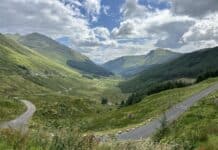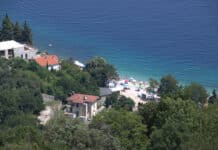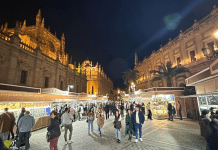Introducing Naxos
Having spent four days on Andros Island, I now had a taste for Aegean adventures, so I was excited to be travelling on to Naxos, the largest of the Cyclades Islands in Greece.
The island is renowned for being laid back and hospitable, not to mention its stunning beaches, crystalline waters, and picturesque villages. Naxos offers an idyllic escape for holidaymakers seeking sun, sea, and relaxation. But beyond its coastal charms, the island boasts a wealth of cultural treasures, including ancient ruins, medieval architecture, and traditional festivals.
Whether you’re lounging on golden sands, exploring historic sites, or savouring local cuisine in charming tavernas, Naxos promises an unforgettable holiday experience that captures the essence of Greek island life.
Let’s find out what I discovered!
Travelling to Naxos
Some of you will fly to Athens and then pick up a ferry from the Port of Rafina to Naxos. You can also catch a ferry from Santorini or Mykonos.
I had already travelled to Andros, so I took the SeaJet ferry from Andros involving a stop at Tinos and Mykonos before pulling into Naxos. Overall, the journey was just over 2 hours and a one-way ticket costs 40 euros during this time of the year (early June).
As we approached the port, I could immediately see one of the symbols of Naxos – the castle or Kastro, towering over Naxos Old Town or Chora below. Many towns in the Cyclades Islands have their main town known as Hora or Chora. In English, this word means “Town or Village”.
I was met by Kostas who picked me up at the bustling little port and drove me no more than 10 minutes to the Princess Mare Hotel where I was to stay for three nights in the centre of Chora, Naxos Old Town. The location was ideal – just 100 yards from the beach and not much further from the main promenade and harbour.


First Impressions of Naxos
Compared to the island of Andros, Naxos was busier, and with the harbourside restaurants already buzzing this early in the season, it was clear to me that this was going to be a different experience. I guess this is the beauty of Greek Island hopping. Each offers its own unique vibe and experience. I welcomed the sudden buzz of Naxos and was keen to discover more.
Having arrived on a barmy spring afternoon I quickly check-in and took a short stroll into town for a look around and dinner.
The Temple of Apollo – Portara
As I made my way into Chora the sun was setting, and I noticed crowds of people at the far end of town. They were gathering up on the rocks on the little islet of Palatia which is connected by a slim artificial causeway. They were not only enjoying the sunset but also viewing and taking selfies by the monument known as the Gate of Portara which translates to “doorway”.
Dating back to the 6th century this “doorway” is the entrance to a temple that is dedicated to the God, Apollo and is one of the most iconic and symbolic landmarks on the island.
When in Naxos, make sure one evening at least, you take time to sit on the rocks and just enjoy mother nature at its very best.


Boulamatsis Restaurant
Dinner was at the Boulamatsis Restaurant which is tucked away behind the main promenade but with a terrace overlooking the harbour. This bustling traditional Naxos restaurant serves up an array of seafood and meat dishes accompanied by salads.
As is often the case when I am let out without a minder, I messed up on the menu order. Simply put – one was hot tomatoes and cheese; one was cold tomatoes and cheese and then the main course of pork belly. All were delicious – I just wish the waiter had pointed out I was ordering the same thing as there are only so many tomatoes and pieces of cheese a man can take!
Naxos By Night
Wandering around the shops in the back streets of Chora is a delight. There is no litter, no dogs, no problems – just a relaxing air to a town that was starting to get busier for the impending season.
For a late-night drink and just one for the road, of course, I stumbled across the Rum Bar. In the heart of the marina and on the first floor, this super cool bar with great summer tunes and vibes was superb. From its attentive staff to its stylish and tasteful decor, you could tell this place had a little class. I noticed that it ranked number 2 on Trip Adviser for the best bars in Naxos.
One for the road turned into a couple, before taking a walk back to my hotel for an early night. Tomorrow I had an organised tour, exploring some of the history and traditional towns and villages of Naxos.


Day 2 on Naxos
After breakfast, I was met at 9 am by Angela (Aggeliki) from Naxos Bus Transfers. This may sound like a rather simple company name as they also organise island excursions as well as transfers and are located at the bus station at the port end of the marina.
Angela was originally from Athens but moved over to Naxos a few years ago to escape the busy city life. She now enjoys her summers guiding tourists around Naxos, while in the Winter months, she paints and coordinates art exhibitions.
A Traditional Naxos Farm
Our tour commenced with a visit to a traditional farm near the village of Filoti on Naxos. We arrived as Stefanos, the owner, was due to start milking 300 goats and sheep. Despite his schedule, he stopped and graciously offered us a selection of delectable cheese samples and a potent glass of Rakhi. A couple of those before 9 am every morning and I think I could milk 300 goats and sheep in the blink of an eye.
Stefanos took us around his cheese-making rooms where the milk is first heated and then packed into moulds for eight days. It then matures over three months before he can sell to visitors and local businesses and restaurants. The farm produces three varieties: a soft salty cheese, and two harder types ideal for pasta and salads.
Having seen how it is made, Stefanos needed to crack on and get milking. I followed as we entered a dimly lit, fly-infested stone barn, where both Stefanos and his daughter took on a herd of 30 goats. They battled to control each of these mischievous characters, before milking them. I loved this demonstration but could only feel that this was a tough job. They took 30 minutes to milk these 30 and with another 270 to go their days are clearly long and physically hard.
After what was a lovely visit, we left him and his daughter to crack on with the remainder of the herd.




Filoti Village
Just a few minutes from the farm and 19 kilometres from Chora is the incredible village of Filoti, where we would learn about both past and modern local life.
Perched on the slopes of Mount Zas, the highest peak in the Cyclades, Filoti offers breathtaking panoramic views of the surrounding landscapes. This area is popular with outdoor enthusiasts for hiking, mountain biking and exploring nearby natural wonders such as the Cave of Zas.
Filoti boasts a rich cultural heritage that is evident in its whitewashed houses, narrow alleyways, and quaint squares adorned with vibrant bougainvillaea. A stroll through the village reveals historic churches, including the imposing Panagia Filotitissa Church, and the Venetian Tower, which dates to the 11th century and features stunning Byzantine frescoes.
Filoti showcases the traditional way of life in both tranquil and authentic surroundings. Visitors can explore local tavernas and cafes, where they can savour authentic Greek cuisine and mingle with friendly locals.
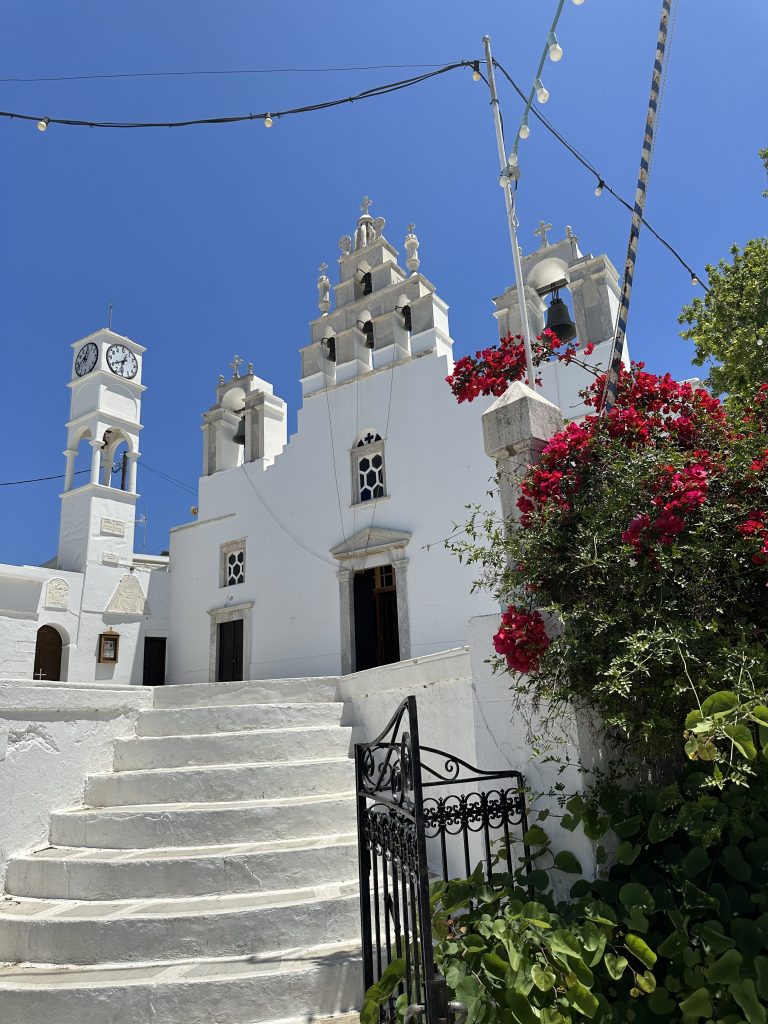


Fassolas
The neighbourhood of Fassolas is a quite remarkable area to discover. Before the construction of the main road from Chora to Apeiranthos, the neighbourhood was the centre of commerce, crafts and social events of Filoti. There were small business premises, such as grocery stores, bakers, tailors, cobblers, blacksmiths, carpenters, olive mills and a distillery, as well as cafes and restaurants.
Fasolas sadly lost its appeal when almost all the shops were moved to the main road. Thankfully all the old buildings were left intact and today they have been restored to their former glory with love and passion by dedicated individuals such as Nikos Moustakis.
I loved wandering along these pretty streets while Nikos proudly showed me each of the shops from yesteryear. It truly is stepping back in time and there are even some artefacts that remind me of my youth, including pots of Nivea Crème, that my mother used to swear by!
Also, there is a small but fabulous museum dedicated to the history of coins and money, not just in Greece but all over the world.



Chalki Village
In the heart of Chalki village, the old capital of Naxos, lies a small distillery, founded in 1896, called the Vallindras Distillery.
The distillery is free to enter. You can enjoy a tour of the museum that charts the history of the distillery and the equipment used through the ages to distil the leaves of the Citron tree. Following the tour, you can sample the traditional Kitron liqueur that’s unique to Naxos. Of course, if it’s to your taste you can purchase a bottle or two!
Chalki village itself is gorgeous and worth wandering around the handmade jewellery shops or just stopping at a pretty café and watching the world go by.



Kaloxilos
The village of Kaloxilos, on Naxos Island, is very much recommended. Far removed from the tourist crowds, Kaloxilos offers a glimpse into traditional island life, where time seems to stand still amidst the rustic beauty of its surroundings.
As you wander through the winding cobblestone streets of Kaloxilos, you’ll be greeted by whitewashed houses adorned with colourful flowers, friendly locals, and a sense of tranquillity that pervades the air. The village square, shaded by ancient trees, serves as a gathering place for residents and visitors alike, offering a glimpse into everyday life on the island.
Visit the Olive Oil Mill that dates to the 19th century and where you can learn about the production of olive oil, soap, and homemade tapenades. The mill closed in 1985 but since then it has been restored and the machines and artefacts preserved. At the end of the tour, you are invited to sample the various flavoured virgin olive oils and other produce.
For outdoor enthusiasts, Kaloxilos is the perfect base for exploring the natural beauty of Naxos. Lace up your hiking boots and set out on scenic trails that wind through olive groves, vineyards, and rolling hills, offering breathtaking views of the Aegean Sea and the surrounding countryside. Or venture off the beaten path and discover hidden beaches, secluded coves, and picturesque landscapes.



Damalas
We enjoyed the liquor, the cheese, and the olive oil and now it was time to visit the Limpertas Manolis Pottery in the village of Damalas.
Here you can watch as skilled craftsmen create all manner of pots and even bird whistles. The prices are extremely good and far better than those you find in the main towns.
I particularly liked the wine mug known as a Pythagorean cup. Should you be greedy and pour yourself too much wine then the whole mug empties via a siphon effect! Now I know a few people who would come a cropper!


Naxos Old Market
After a day out and about exploring the island I wandered into Chora, Naxos Town and decided to check out the Old Market which is very popular with tourists. The pretty colourful streets are full of fashion, jewellery, and souvenir shops. Whilst I enjoyed the ambience the prices were quite high compared to the villages which you would expect.
I took a pre-dinner drink at the Cream on Top Bar located on the marina edge looking along the promenade. The comprehensive cocktail and spirits menu included Finlandia Vodka and Coke for 7 euros. I felt this was worth it for the view, although the rather direct request from the waitress to consider offering a tip was not necessary. If you deliver good service then good things will come, like anything in life, I guess.

Dinner at Yasouvlaki
Restaurants start to fill from about 8 pm with most not taking advanced reservations. Tonight, I was dining at the Yasouvlaki restaurant directly in front of the marina on the promenade.
The restaurant offered a choice of traditional Greek dishes, Souvlaki, Veal, Pork, Burgers, and Salads. The staff were very friendly and welcoming and the food was excellent. I learned that in the peak summer months, the restaurants stay open till 06:30 am!


Day 3 on Naxos
My last full day on the island of Naxos involved hiring a car and getting out on the open road. I was to spend my day travelling from Naxos Town in a southerly direction, along the West coast of the island. It was here that I was told the best beaches are to be found, along with some other places of interest.
My car hire was from the lovely people at MotoNaxos. When I turned up there were several 4X4 beach buggies available for hire, which I have to say, looked great fun. However maybe those days for me are over, so I took a basic car which to be fair was ideal for what I required.

Pirgaki Beach
I decided to drive to my most southerly destination first then work my way back to Naxos Town. The first stop was a highly-rated beach called Pirgaki where I parked on the beach. Bearing in mind I was arriving on a hot sunny day at the beginning of June the wide-open glorious sandy beach was almost deserted, aside from a couple of sunbathers. The main reason I guess, was due to the winds in this part of the island but on the day, I was there it was a little breezy but not uncomfortable.
I liked this wild open beach and consider it a bit of a hidden gem. It was magnificent and perfect for those of you wanting a little peace. Note there were no sun loungers or areas of shade.



Alyko
It had been suggested that I visit the village of Alyko. As with many seaside locations along this western stretch of Naxos the beaches are superb. Here at Alyko, there was a lovely, popular, secluded beach along with many small coves and sandy bays. However, the beaches were not the reason I was here!
On the peninsula, there are the ruins of a derelict 60s hotel that has been turned into an open-air art centre with various pieces of superb graffiti adorning the walls. A Balinese street artist is said to be the man responsible for these works. As you wander around the site, you then start to get a little braver and step inside some of the old hotel rooms. As your eyes adjust to the light, further works appear in the dark, along with people who are maybe tourists, artists or people sleeping rough. Yes, it is a little edgy but that’s part of its appeal.
I understand that there is a battle going on locally to preserve these ruins rather than let them be bulldozered for yet another hotel or set of apartments. This was one of the highlights of my entire visit to Naxos, so you can guess which camp I am in!
The beach is backed by an ancient Cedar Forest which is both beautiful and important for the local wildlife and nature that frequents these parts.









Glyfada Beach
The beautiful sandy beach of Glyfada is found between Alyko and Kastraki. It is another beautiful long sandy beach, in fact, one of the longest on the island. Once again it was quiet probably due to the fact it was exposed to the strong winds. If you pick the right day, I can imagine this is another heavenly spot!
Kastraki Beach
Kastraki is another beautiful beach set on the western Naxos coast. It is positioned between Glyfada and Mikri Vigla Beach.
It has many free areas where you can lay on a beach towel, however, there are a limited number of kiosks where you can hire sunbeds with umbrellas. The northern end of this beach is rockier and offers some areas of shade.


Cape Mikri Vigli
Cape Mikri Vigli is the place on Naxos to go if you are into kite and windsurfing. The area is packed with surf schools that are available to teach you a range of water sports activities whether you are a beginner or an experienced pro!
Parking here was a little difficult but once I had found a space and looked around it was clear that this was the cool place to be. The beach was packed with trendy surf dudes and chicks (am I allowed to refer to people like that these days?) enjoying the fresh air, a gorgeous beach and some magical waters and great surfing conditions.


Plaka Beach
Plaka Beach is the longest of all the beaches in Naxos and just 15 minutes from Naxos Town. This four-kilometre stretch of golden sands boasts a selection of seaside accommodations, ranging from cosy guesthouses to luxurious beachfront resorts.
Visitors can indulge in delectable Greek cuisine at the charming tavernas lining the shore, where freshly caught seafood and traditional dishes are served with a side of stunning sea views. I parked up in a large car park alongside the Three Brothers Tavern which was quite eerily quiet – maybe they knew I was coming!
Being one of the island’s most popular beaches you can expect to find trendy beach bars who charge a fair price for drinks and the right to be on their patch!
Adventure-seekers can also partake in a variety of water sports, including windsurfing, kayaking, and paddleboarding.


Agia Anna
Agia Anna is a pretty bay and a popular spot for sunbathing. The bay attracts scuba divers as it is an area protected from the northern winds. This is organised locally by the Naxos Diving Centre and run by Nikos. They take groups all year round from individuals up to 10 people. The dives cost 70 euros per person and last about 2.5 hours, with 45 minutes of that underwater, subject to the level of ability.
The bay is also popular for both fishing boats and tourist boats who organise excursions daily, subject of course, to the weather conditions.



Prokopis Beach
Considered by many to be the best beach on Naxos, Prokopis is once again that perfect Mediterranean beach. Golden sands, shallow waters that are ideal for families, and backed by a wide choice of excellent restaurants, cafes, and bars.
One such bar I stopped at for a refreshing drink was the classy Kahlua Beach Cafe which offers cocktails and a very relaxing and enjoyable atmosphere.


Laguna Beach
With the day coming to an end, I wanted to end my journey by travelling along the coast via a beach that had been recommended to me for the wildlife, particularly the birds. This was Laguna Beach.
I pulled up and found a beach hut from where a guy was offering windsurfing lessons. As I passed, I started to walk along the beach and for the first time all day was shocked at what I experienced. The entire beach was covered in rubbish and plastics.
I approached the guy in the kiosk, and he confirmed that this was a problem that affected this beach due to the winds bringing in the litter. Feeling a little upset at what I had witnessed, I asked him if they do beach cleans, and his response was they do. However, he went on to say that whilst this was a good thing it was soul-destroying as the following day the plastic was back.
Without a moment’s hesitation, I asked him for some bin liners and over the next hour I cleaned the beach from one end to the other, collecting two bags of plastic bottles, nets, sun cream lotions and a host of other unsavoury items.
It was ironic that I had been sent to this beach to study the wildlife, yet it was the actions of humans that left me so disappointed. I was however pleased with what I had done, and as I left, the kind guy at the windsurf school gave me a keyring – made from recycled plastic.



Dinner at Meze *2
That evening, I headed into town for dinner at Meze *2 on an outside terrace on the main promenade. The speciality here was seafood and the jovial waiter took great delight in ensuring I chose well. That meant the fish of the day! There was also a variety of other main dishes including salads, pasta dishes and meats.
As an idea of prices salads start from 7 euros, seafood mains from 10 euros, and a litre of wine from 12 euros.
After a lovely dinner, it was time to retire after a long day exploring this beautiful island.


Day 4 On Naxos
I was on a mid-afternoon ferry to Naxos, so without wanting to waste time, I thought I should go and explore more of Chora, Naxos Old Town, and particularly the castle.
The Kastro, Naxos Old Town
Towering over Naxos Old Town is the 13th-century citadel, or Kastro. I could not leave Naxos and not take the lung-bursting walk up to the top for not only the views but also to uncover some of the hidden treasures within the alleyways and city walls.
The Castle has two entrance gates: the main gate to the south is the Paraporti, and the northern gate is the Trani Porta where the Della Rocca Barozzi Tower is of significant interest.
As you walk the streets, and probably get lost, you will find many shops which are ideal to use up your last few euros before you come home! You may need a bit of time as the various antique shops, fashion houses and jewellers are the best in town.
I came across a couple of interesting museums. The Venetian and Folk History Museum includes furniture and artefacts while also hosting regular art events. The Archaeological Museum has works of art and objects from the Late Neolithic times to the Early Christian period.
Close to the main square is the Catholic Cathedral while you can also enjoy one of the oldest buildings in Naxos, the Orthodox Church of Panagia Theoskepasti. There is also the Capuchin Monastery so lots of history to discover.
In need of a drink after the walk up to the top, I found the Avaton – a rather gorgeous, historic place to take a Coffee, Brunch or Wine on its sun terrace. If you are looking for the very best views of Naxos Town, then go to the Avaton as it’s wonderful!




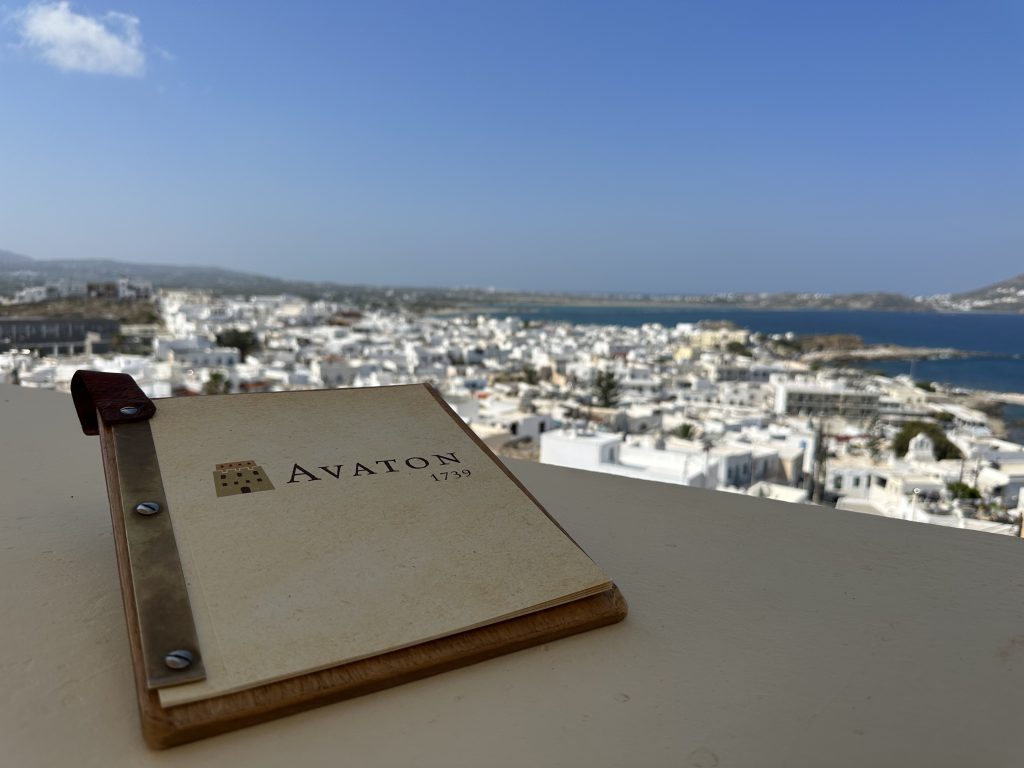
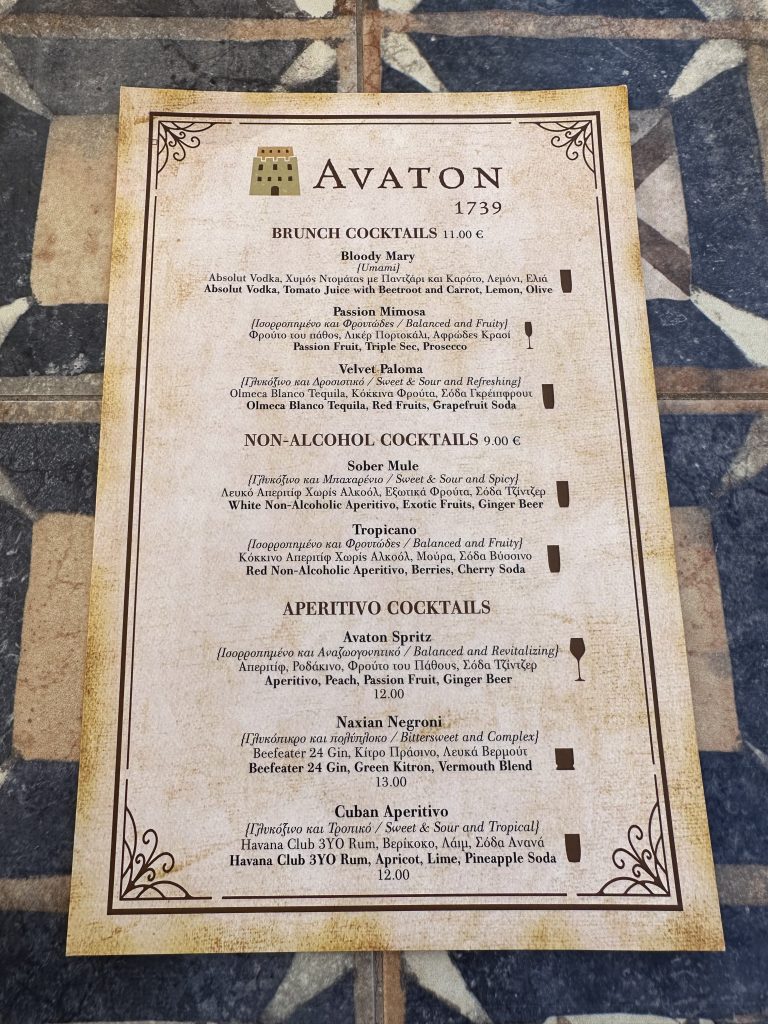
Naxos Marina
Once down from the Castle, I took a little time to wander along the promenade and admire the busy Marina. Numerous tourist vessels are parked up at the front while the larger yachts and boats are moored up behind. The picturesque scene of Naxos Town, framed by numerous cafes and bars overlooking the marina, is a great place for a leisurely breakfast or a relaxing evening drink.
With just an hour to go before I left the island, I took a Cappuccino at the Cream On Top Bar overlooking the Marina and Kastro and reflected on my stay on the island.



Final Thoughts On Naxos
Arriving from the much quieter island of Andros it came as a shock at first to experience the busy bustling Old Town and lively beaches of Naxos. However, having explored the island I liked the fact you could find that deserted beach just a few kilometres from one that offers a very different experience with water sports, bars, and beach clubs.
Naxos has much to offer, and I enjoyed my stay. It’s a great place for a holiday, especially for families with those amazing beaches, and for historians keen to discover the island’s past.
The next stop was Mykonos… till next time!

With Thanks
My thanks to Visit Greece, to Angela for showing me around Naxos and to MotoNaxos for the hire of the car – both trips I thoroughly enjoyed!
Contact Information
For more information on visiting Naxos Island in the Cyclades, Greece contact your local travel agent or specialist tour operator.
For local specialist expertise then please contact Naxos Bus Transfers.


